Background
The ill-disciplined Crusaders, especially in the German Crusade, had caused a number of incidents with the passage of the crusading army through the Balkans. The Byzantine emperor, Manuel I Comnenus, feared that the troops of the crusaders would strengthen the Principality of Antioch, which he wanted to restore to his sovereignty, and also would weaken the Byzantine-German alliance against Roger II of Sicily. While Conrad III and Louis VII refused to pay homage to the Byzantine emperor in the autumn of 1147, they retained the Byzantine troops. Consequently, Roger II seized Corfu and Cephalonia, and plundered Corinth and Thebes.
The French and Germans decided to take separate routes. Conrad's army was defeated at the Battle of Dorylaeum 25 October 1147.
The remnants of the army of Conrad were able to join the army of the king of France. The armies followed the path left by the first Crusaders advance to Philadelphia in Lydia. In this city, the Germans were still exposed to attack and decided to return to Constantinople. Conrad III, reconciled with Manuel, captured Acre with Byzantine ships. The troops of Louis VII followed the coast and then took the road to the east. The Seljuks waited on the banks of the river Meander, but the Franks forced the passage and marched to Laodicea, which they reached on 6 January, the day of the Epiphany. They then marched to the mountains that separate Phrygia from Pisidia.
Battle
The vanguard, led by Geoffrey de Rancon, was recklessly placed too far ahead of the army. King Louis, with the main column, ignored that fact, and proceeded onward. The French soldiers walked with confidence, convinced that their comrades occupied the heights in front of them. However, the Seljuks had the advantage when the French ranks broke and rushed upon them swords in hand. The French retreated to a narrow gorge, bordered on one side with precipices and crags on the other. Horses, men, and baggage were forced into the abyss. King Louis VII was able to escape the fray, leaned against a tree and stood alone against multiple attackers. [3] At night, the king took advantage of the darkness to join the vanguard of his army, which had been believed dead. [4] After the battle, the army of the king of France, which had suffered heavy losses, barely reached Attaleia on 20 January.

The 12th century is the period from 1101 to 1200 in accordance with the Julian calendar. In the history of European culture, this period is considered part of the High Middle Ages and overlaps with what is often called the "'Golden Age' of the Cistercians". The Golden Age of Islam experienced significant development, particularly in Islamic Spain.
Year 1142 (MCXLII) was a common year starting on Thursday of the Julian calendar.
The 1140s was a decade of the Julian Calendar which began on January 1, 1140, and ended on December 31, 1149.
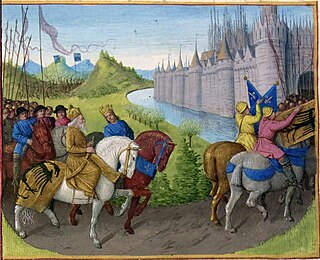
Year 1147 (MCXLVII) was a common year starting on Wednesday of the Julian calendar.
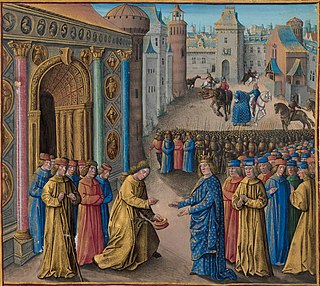
Year 1148 (MCXLVIII) was a leap year starting on Thursday of the Julian calendar.
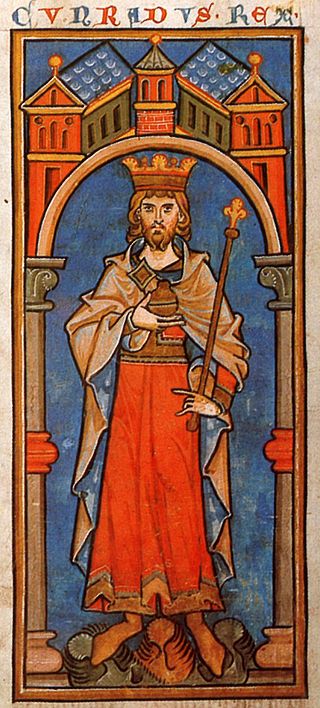
Conrad III of the Hohenstaufen dynasty was from 1116 to 1120 Duke of Franconia, from 1127 to 1135 anti-king of his predecessor Lothair III, and from 1138 until his death in 1152 King of the Romans in the Holy Roman Empire. He was the son of Duke Frederick I of Swabia and Agnes, a daughter of the Salian Emperor Henry IV.
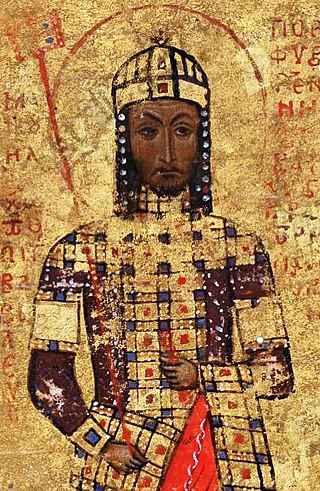
Manuel I Komnenos, Latinized as Comnenus, also called Porphyrogenitus, was a Byzantine emperor of the 12th century who reigned over a crucial turning point in the history of Byzantium and the Mediterranean. His reign saw the last flowering of the Komnenian restoration, during which the Byzantine Empire had seen a resurgence of its military and economic power and had enjoyed a cultural revival.
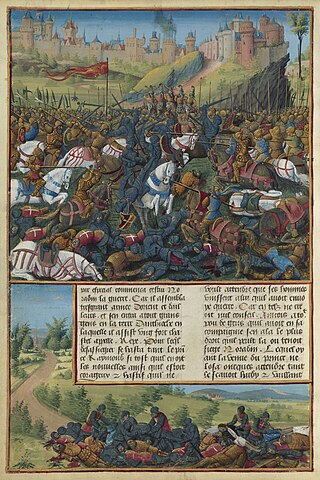
The Second Crusade (1147–1150) was the second major crusade launched from Europe. The Second Crusade was started in response to the fall of the County of Edessa in 1144 to the forces of Zengi. The county had been founded during the First Crusade (1096–1099) by King Baldwin I of Jerusalem in 1098. While it was the first Crusader state to be founded, it was also the first to fall.
William de Warenne, 3rd Earl of Surrey was an Anglo-Norman nobleman, member of the House of Warenne, who fought in England during the Anarchy and generally remained loyal to King Stephen. He participated in, and ultimately perished during, the Second Crusade.
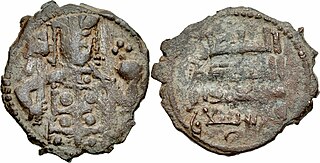
Rukn al-Dīn Mesud Klada ibn Kilij Arslan or Mesud I (Modern Turkish: I. Rükneddin Mesud or Masud was the sultan of the Sultanate of Rûm from 1116 until his death in 1156.

The siege of Damascus took place between 24 and 28 July 1148, during the Second Crusade. It ended in a crusader defeat and led to the disintegration of the crusade. The two main Christian forces that marched to the Holy Land in response to Pope Eugene III and Bernard of Clairvaux's call for the Second Crusade were led by Kings Louis VII of France and Conrad III of Germany. Both faced disastrous marches across Anatolia in the months that followed, with most of their armies being destroyed. The original focus of the crusade was Edessa (Urfa), but in Jerusalem, the preferred target of King Baldwin III and the Knights Templar was Damascus. At the Council of Acre, magnates from France, Germany, and the Kingdom of Jerusalem decided to divert the crusade to Damascus.
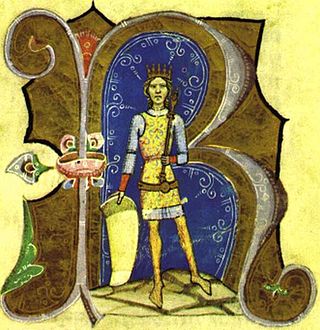
Géza II was King of Hungary and Croatia from 1141 to 1162. He was the oldest son of Béla the Blind and his wife, Helena of Serbia. When his father died, Géza was still a child and he started ruling under the guardianship of his mother and her brother, Beloš. A pretender to the throne, Boris Kalamanos, who had already claimed Hungary during Béla the Blind's reign, temporarily captured Pressburg with the assistance of German mercenaries in early 1146. In retaliation, Géza, who came of age in the same year, invaded Austria and routed Henry Jasomirgott, Margrave of Austria, in the Battle of the Fischa.

The Crusades were a series of religious wars initiated, supported, and sometimes directed by the Christian Latin Church in the medieval period. The best known of these military expeditions are those to the Holy Land in the period between 1095 and 1291 that were intended to reconquer Jerusalem and its surrounding area from Muslim rule. Beginning with the First Crusade, which resulted in the conquest of Jerusalem in 1099, dozens of military campaigns were organised, providing a focal point of European history for centuries. Crusading declined rapidly after the 15th century.

Wars between the Normans and the Byzantine Empire were fought from c. 1040 until 1185, when the final Norman invasion of the Byzantine Empire was defeated.

The second Battle of Dorylaeum took place near Dorylaeum in October 1147, during the Second Crusade. It was not a single clash but consisted of a series of encounters over a number of days. The German crusader forces of Conrad III were defeated by the Seljuk Turks led by Sultan Mesud I.

The Council of Acre met at Palmarea, near Acre, a major city of the crusader Kingdom of Jerusalem, on 24 June 1148. The Haute Cour of Jerusalem met with recently arrived crusaders from Europe, to decide on the best target for the crusade. The Second Crusade had been called after the fall of Edessa to Zengi in 1144. In 1147, armies led by Conrad III of Germany and Louis VII of France began their separate journeys to the east. Conrad arrived at Acre in April 1148, and Louis marched south from Antioch.
The Battle of the Meander took place in December 1147, during the Second Crusade. The French crusader army, led by Louis VII of France, successfully fended off an ambush by the Seljuks of Rum at the Meander River.
The Battle of Ephesus took place on 24 December 1147, during the Second Crusade. The French crusader army, led by Louis VII of France, successfully fended off an ambush by the Seljuks of Rum just outside the town of Ephesus.
The Battle of Constantinople in 1147 was a large-scale clash between the forces of the Byzantine Empire and the German crusaders of the Second Crusade, led by Conrad III of Germany, fought on the outskirts of the Byzantine capital, Constantinople. The Byzantine emperor Manuel I Komnenos was deeply concerned by the presence of a large and unruly army in the immediate vicinity of his capital and of the unfriendly attitude of its leaders. A similarly sized French crusader army was also approaching Constantinople, and the possibility of the two armies combining at the city was viewed with great alarm by Manuel. Following earlier armed clashes with the crusaders, and perceived insults from Conrad, Manuel arrayed some of his forces outside the walls of Constantinople. Part of the German army then attacked and was defeated; according to British historian Michael Angold, they suffered heavy losses. Following this defeat the crusaders agreed to be quickly ferried across the Bosporus to Asia Minor.
The Byzantine–Hungarian War was a series of border conflicts between the Byzantine Empire and the Kingdom of Hungary that took place in the Balkans from 1149 to 1155. The conflict was affected by international disputes in Europe, primarily between Manuel I Komnenos and Roger II of Sicily, starting in the 1140s. The war broke out when Géza II of Hungary provided military assistance to the Serbs of Rascia (Raška), who rebelled against Byzantine suzerainty. The conflict ended with a peace treaty that restored the status quo ante bellum and established peace for five years. In 1161, the parties agreed to extend the truce for ten years but the relationship between them remained hostile, causing further clashes throughout the 12th century.












